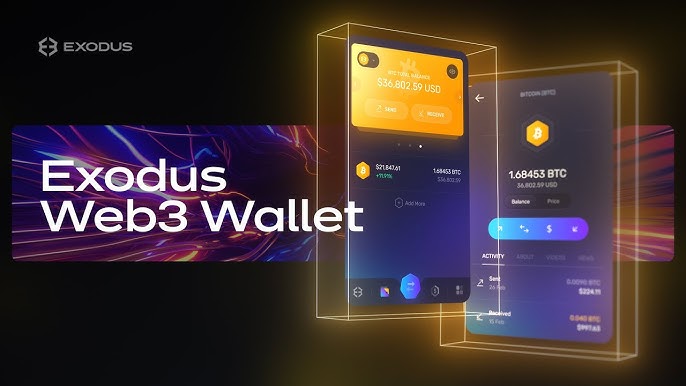In the ever-evolving world of cryptocurrency, security, exodus wallet download convenience, and user experience are paramount for anyone seeking to manage their digital assets effectively. Among the numerous cryptocurrency wallets available, Exodus Wallet has carved out a distinct reputation. Known for its intuitive design, robust features, and versatile support for various cryptocurrencies, Exodus is a popular choice for both newcomers and experienced traders. In this article, we’ll explore the features, benefits, and key elements that make Exodus Wallet stand out in the crowded crypto landscape.
What is Exodus Wallet?
Exodus Wallet is a non-custodial cryptocurrency wallet, which means users retain full control of their private keys and funds. Developed in 2015 by JP Richardson and Daniel Castagnoli, Exodus was built with the goal of simplifying cryptocurrency management. The wallet is available as both a desktop and mobile application, allowing users to manage their digital assets seamlessly across multiple devices.
One of Exodus’ standout features is its focus on user experience. The wallet’s sleek, easy-to-navigate interface makes it ideal for beginners, yet it is packed with powerful tools that satisfy the needs of advanced traders.
Key Features of Exodus Wallet
- Multi-Currency Support: Exodus supports a wide range of cryptocurrencies, including popular ones like Bitcoin (BTC), Ethereum (ETH), and Litecoin (LTC), as well as many altcoins. With Exodus, users can store and manage their entire portfolio within a single wallet. Additionally, the wallet integrates with Trezor hardware wallets, expanding support for even more assets.
- Built-in Exchange: Exodus allows users to swap cryptocurrencies directly within the wallet through its built-in exchange feature. This is made possible through Exodus’ partnership with ShapeShift, a renowned decentralized exchange platform. With just a few clicks, users can swap one cryptocurrency for another without leaving the wallet, eliminating the need to use third-party exchanges.
- User-Friendly Interface: Exodus is designed to be user-friendly and visually appealing. The wallet features an interactive portfolio tracker that visually represents your holdings through pie charts. Users can quickly view their assets, track price movements, and get an overview of their portfolio in real time. For beginners, the wallet’s simplicity can be a huge benefit, providing easy access to the crypto world without feeling overwhelmed.
- Security: While Exodus is not a hardware wallet, it offers a solid layer of security to protect users’ funds. As a non-custodial wallet, users maintain control over their private keys, meaning only they have access to their funds. Exodus also offers a backup feature, allowing users to create a 12-word recovery phrase. This ensures that if a user loses access to their device, they can recover their wallet on another device.
- Mobile and Desktop Versions: Exodus is available for both desktop (Windows, macOS, Linux) and mobile (iOS, Android) devices. This cross-platform support ensures that users can easily manage their assets on the go, with the same seamless experience across devices.
- Staking: For cryptocurrency enthusiasts looking to earn passive income, Exodus also supports staking for select assets, such as Cardano (ADA) and Tezos (XTZ). Staking allows users to earn rewards by participating in network validation processes without the need to sell their holdings.
- 24/7 Customer Support: Exodus offers comprehensive customer support through a dedicated support team, providing assistance through email, live chat, and a detailed knowledge base. This level of support helps ensure that users can resolve any issues quickly and effectively.
How to Set Up Exodus Wallet
Setting up Exodus Wallet is incredibly simple and user-friendly. Here’s a quick guide to get you started:
- Download the Wallet: Visit the official Exodus website or the respective app store for mobile devices to download the wallet.
- Install the Wallet: After downloading, follow the installation prompts for either the desktop or mobile version.
- Create a New Wallet: Upon opening Exodus for the first time, users are prompted to create a new wallet. Make sure to save your 12-word recovery phrase in a secure location, as it’s the key to restoring your wallet if necessary.
- Fund Your Wallet: After setting up your wallet, you can begin adding funds by receiving cryptocurrency. Simply select the “Receive” button for the cryptocurrency you want to deposit and follow the instructions to generate an address.
- Begin Trading or Staking: Once your wallet is funded, you can begin trading, staking, or swapping your assets directly from the wallet interface.
Benefits of Using Exodus Wallet
- Beginner-Friendly: Exodus’ simple and attractive interface makes it perfect for beginners. The wallet’s guided design helps users understand how to store, send, and receive cryptocurrencies without feeling intimidated by the complex world of crypto.
- All-in-One Solution: Exodus combines multiple features into one platform, such as portfolio management, built-in exchanges, staking, and cross-platform compatibility. This comprehensive approach simplifies the crypto experience.
- Privacy: Exodus doesn’t collect personal data, ensuring privacy for users. As a non-custodial wallet, Exodus places the responsibility of securing funds entirely in the hands of the user, aligning with the decentralized ethos of cryptocurrencies.
- Customizable Fees: Exodus allows users to adjust transaction fees, enabling them to optimize their costs based on network conditions. This gives users more control over their transactions, particularly during periods of network congestion.
Drawbacks of Exodus Wallet
While Exodus Wallet offers a wealth of features, it’s important to be aware of some of the limitations:
- Not Fully Decentralized: Despite its non-custodial nature, Exodus relies on ShapeShift for in-wallet exchanges, which introduces an element of centralization. Users seeking complete decentralization may prefer wallets that do not integrate with third-party services.
- No Native Hardware Integration (Outside Trezor): While Exodus integrates with Trezor hardware wallets, it does not offer native support for other hardware wallets, limiting options for those who prefer storing their private keys offline for extra security.
- Limited Staking Support: Although Exodus supports staking for certain cryptocurrencies, the selection is relatively limited compared to other platforms that offer staking for a broader range of assets.
Conclusion
Exodus Wallet is an excellent choice for cryptocurrency users who value simplicity, security, and versatility. Its combination of an intuitive interface, multi-currency support, built-in exchange, and staking options makes it a one-stop shop for crypto enthusiasts. Whether you’re a beginner just getting started or an experienced trader looking for a smooth and efficient way to manage assets, Exodus provides a user-friendly and feature-packed solution.
However, users looking for complete decentralization or advanced hardware wallet integration may find some limitations. Overall, Exodus remains one of the most popular and trusted wallets in the crypto space for good reason—its focus on ease of use, security, and continuous improvement makes it a compelling choice for anyone in the world of digital finance.



